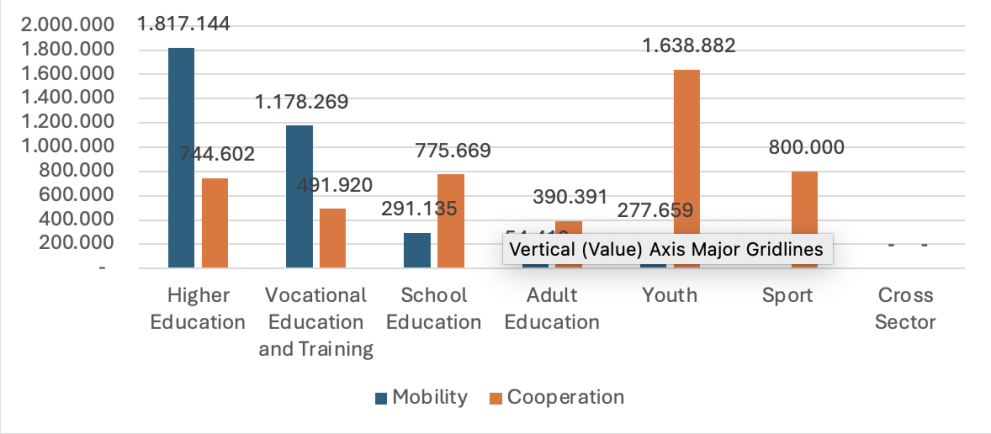
10.3 Support to youth work
On this page
Youth Strategy in the Republic of Serbia for the period from 2023 to 2030 is the main public policy document in the field of youth in the Republic of Serbia which recognises youth work within the first out of five specific goals – “Youth work is standardised in the system of non-formal education and is continuously implemented“. Achievement of the goal will be verified through the 4 Outcome indicators presented in the table below:
| Outcome indicator | Baseline value | Target value (2030) | Source of verification |
| Indicator 1 – Publicly recognised organisers of adult education activities in youth work have been established | No | Yes | Data from the Qualifications Agency |
| Indicator 2 – Professional association of youth workers has been established | No | Yes | Business Registers Agency |
| Indicator 3 – Number of young people who participated in publicly funded programmes/projects/services organised by certified youth workers on an annual basis | No data | 10,000 young people (of whom at least 1,000 young people with disabilities and 1,000 young people from other vulnerable groups) | Report of the National Association of Youth Work Practitioners / reports of programme / project / service implementers |
| Indicator 4 – Number of supported programmes and activities implemented by certified youth workers | No data | 100 | Reports of project implementers and NAPOR |
Source: Strategy for Youth in the Republic of Serbia for the period from 2023 to 2030
Realisation of the Specific Goal 1 assumes implementation of six specific measures. Successful implementation of the measures will be verified through the respective set of output indicators as presented in the table below:
|
Measure |
Content |
Output indicators |
Baseline value |
Target value |
Source of verification |
|
1.1 |
Developed system of professional development of youth workers |
Indicator 1 - Adopted standard of qualification of youth workers |
No |
Yes |
Qualifications Agency |
|
Indicator 2 - Number of certified youth workers |
None |
Number of certified youth workers |
NAPOR database |
||
|
Indicator 3 - Percentage of certified youth workers among YO coordinators and representatives of associations |
None |
20% for YOs and 20% for associations |
Database of NAPOR, LSGUs, associations |
||
|
1.2 |
A quality assurance system for youth work and non-formal youth education programmes has been established |
Indicator 1 - Standards for quality assurance of youth work programmes have been adopted and are being applied |
No |
Yes |
NAPOR reports |
|
Indicator 2 - Number of accredited programmes that comply with programme quality assurance standards |
None |
100 |
Reports of the Qualifications Agency and NAPOR reports |
||
|
Indicator 3 - Number of youth associations and for young people that have accredited the programme of adult education activities as PROAEA |
1 |
50 |
Report of the Qualifications Agency |
||
|
Indicator 4 - The number of digital programmes of youth work on an annual level, which are in accordance with the standards for ensuring the quality of the programmes |
None |
10 annually |
Database and reports of NAPOR, MoTY, Provincial Secretariat for Sports and Youth, LSGUs, CSOs |
||
|
1.3 |
Youth work programmes are implemented continuously in cooperation with local partners; |
Indicator 1 - Share of local self-government units that provide integrated services for young people |
No data |
50% |
Reports of local self-government units, annual reports of NAPOR |
|
Indicator 2 - Number of integrated services in local self-government annually available to young people |
No data |
300 |
LSGUs’ reports |
||
|
Indicator 3 - Number of supported projects/programmes of youth work within informal education in rural areas of the Republic of Serbia on an annual basis |
None |
100 annually |
NAPOR database, reports of MoTY, Ministry of Rural Care, provincial authority responsible for youth and balanced regional development, LSGUs, CSOs |
||
|
1.4 |
Youth work is recognised in the system of formal and non-formal education and among young people |
Indicator 1 - Percentage of young people who believe that non-formal education programmes implemented by youth workers are important for their personal and professional development |
No data |
30% |
Survey on the position and needs of young people, MoTY |
|
Indicator 2 - Annual number of articles in traditional media (press, radio, TV) on youth work |
No data |
24 |
publications in the print media |
||
|
Indicator 3 - Regional network of youth workers' associations established. |
No |
Yes |
NAPOR reports; MoTY reports |
||
|
1.5 |
Research and knowledge management in the field of youth work and non-formal education of young people are continuously conducted |
Indicator 1 - Number of surveys on youth and youth work in the Republic of Serbia conducted on a representative sample, 182on an annual basis |
6 |
9 |
Website of MoTY, SORS and other research organisers |
|
Indicator 2 - A mechanism for coordination of researchers in the field of youth policy has been established |
No |
Yes |
MoTY reports |
||
|
1.6 |
Harmonisation of youth work within international standards |
Indicator 1 - Number of implemented measures within the international processes of harmonisation of youth work |
2 |
4 |
Minutes from the sessions of the Expert Team for the Implementation of the Bonn Process and the Youth Council |
|
Indicator 2 - Number of international and regional events on youth and youth work in which he participates entities that implement youth policy in the Republic of Serbia on an annual basis |
6 |
10 |
MoTY Annual Report |
Source: Youth Strategy in the Republic of Serbia for the period from 2023 to 2030
Youth activities organised by and for young people, based on non-formal education, carried out in young people’s free time and undertaken with the aim of improving the conditions for personal and social development of young people, in accordance with their needs and abilities, in which young people voluntarily participate are considered as youth work as defined in the Law on Youth (2011).
Guidelines for quality assurance of youth work developed by The National Association of Youth Workers (NAPOR) offers a list of types of activities that are considered as youth work divided according to:
The topics they deal with:
- Political awareness and active citizenship - youth participation, rights and equality, policy and education development, social actions, activism, etc;
- Health education - promotion of healthy lifestyles, relationships and sexuality, stress management, mental health, HIV / AIDS, first aid, alcohol, smoking, etc;
- Prevention of social exclusion - youth work aimed at preventing social exclusion, including education, training and employment opportunities for marginalized groups and individuals. Social integration, transition to adulthood and the labour market are supported.
- Life skills (social education) - programs are both experiential and educational carried out through individual, group work, projects or events that contain aspects of primary prevention but also problem intervention. They are focused on identity development, values, emotion management, leadership, teamwork, planning and decision making, communication, problem solving, initiative and responsibility, professional development and orientation, etc.
- Intercultural and international awareness - professionally guided activities that enable young people from different countries, different ethnic backgrounds and cultures to expand cultural knowledge, build skills and competencies, develop tolerance and acceptance of diversity.
- Youth informing - consists of coordinated services through centres. The goal is to enable young people to make independent, informed decisions that will lead to organizing their own lives.
- Environmental protection - raising the environmental awareness of young people, promoting life in harmony with nature, etc.
- Youth counselling - focused on specific youth issues and problems. It provides information and support based on professional counselling techniques and refers young people to other institutions if necessary.
- Youth work based on free time - includes games, sports, cultural and artistic activities with the aim of developing the physical, intellectual and other potentials of young people. It enables socialization and prevention, has a targeted educational character through a hidden curriculum. This type of youth work is considered as the first step for young people to get involved in other types of youth work.
The site where it is conducted:
- Youth work „on the streets“
- Detached youth work – conducted in places where young people gather
- “Outreach” youth work – short-term activity with the aim of establishing a connection with young people and informing them about the possibilities of involvement in youth work activities
- Club youth work – conducted in youth clubs or centres.
Youth work in Serbia is mainly practiced within youth organisations or associations and organisations or associations for youth. The Law on Youth defines a youth association as an association whose membership represents at least two thirds of young people and whose goals or areas of achievement are aimed at young people. On the other side, an association for youth is any other association whose goals or areas of goal achievement are, among other things, aimed at young people.
Funds for the implementation of the Youth Strategy in the Republic of Serbia for the period from 2023 to 2030 are provided in the budget of the Republic of Serbia, as well as in the budget of the autonomous provinces and local self-governments, including the contribution of EU IPA funds, participation of the private sector, youth activity associations and other national and international programmes and donors (CoE Country sheet on youth work in Serbia). The Action Plan for the implementation of the Strategy for the period from 2023 to 2025 contains budget allocations for implementation of the Strategy for 2023 and preliminary estimate for the whole period 2023-2025. The total amount allocated for 2023 amounts to 3,201,116,142.00 RSD. The total budget envisaged for the period 2023-2025 is 10,648,263,494.00 RSD (approximately 90.9 mln EUR).
The main funder of the youth work activities is the Government of the Republic of Serbia. In 2023, breakdown of the budget expenditures is as follows:
- Ministry of Tourism and Youth – 526,870,000.00 RSD
- Ministry of Rural Welfare – 500,000,000.00 RSD
- Ministry of Science, Technological Development and Innovation – 957,000,000.00 RSD
- Ministry of Culture – 26,343,000.00 RSD
- Ministry of Economy – 913,279,000.00 RSD
- Ministry of Information and Telecommunications – 8,000,000.00 RSD
- Ministry of Environmental Protection – 8,000,000.00 RSD
- Other partnering institutions – 261,624,142.00 RSD
According to the Law on Youth (Article 20) the funds for supporting programmes and projects of public interest in the youth sector are provided in the budget of the Republic of Serbia. Public calls for proposals managed by the ministry are regular mechanism for supporting youth associations and local self-governments.
In line with the Law on Youth (Article 26), units of local self-government could allocate their budget funds for financing the needs and interests of young people. This, however, means that due to respecting the right to autonomy of local self-government and its distinctive needs they do not have a legal obligation to assign certain amounts of funds for youth issues.
Since 2016, the Foundation Tempus has been responsible for providing support to projects related to youth work and youth workers. As of February 2019, Serbia has become an official Programme Country for Erasmus+ which enabled Serbian Higher Education Institutions to sign direct bilateral agreements with other Higher Education Institutions participating in the Programme. Additionally, being a fully-fledged Erasmus+ Programme Country, as of 2019 Serbia enjoys increased budget for financing projects and wider possibilities for youth organisations.
Over the period 2019-2020 Serbia received a total of 9.6 mln EUR grants under Mobility component of Erasmus+ Programme allocated within 245 projects. A total of 617,062 EUR was allocated to the 38 projects in the youth sector under mobility component. Under the Strategic Partnerships component, total value of the 58 approved projects amounted to almost 5.35 mln EUR (338,600 EUR for 7 projects in the youth sector). A total of 254 organisations (25 in youth sector) and 5,145 individuals (1268 in youth sector) participated in the Erasmus+ activities over the period 2019-2020.
In the period 2021-2022 Serbia received a total of 25.9 mln EUR grants under Mobility and Cooperation grant components of the Erasmus+ Programme. A total of 259 and 95 projects have been approved within Mobility and Cooperation components respectively. In the two years period, 905 organisations took participation in the Programme,
Statistics of the financial support provided through ongoing Erasmus+ Programme could be found in the tables below.
Breakdown of Erasmus+ Programme Support in 2021
Figure 1: Total grants approved under Mobility and Cooperation in 2021 (in EUR)

Source: Erasmus+ in Serbia in 2021. Statistics on mobility, cooperation and other data.
Figure 2: Number of projects under Mobility and Cooperation in 2021 per sectors
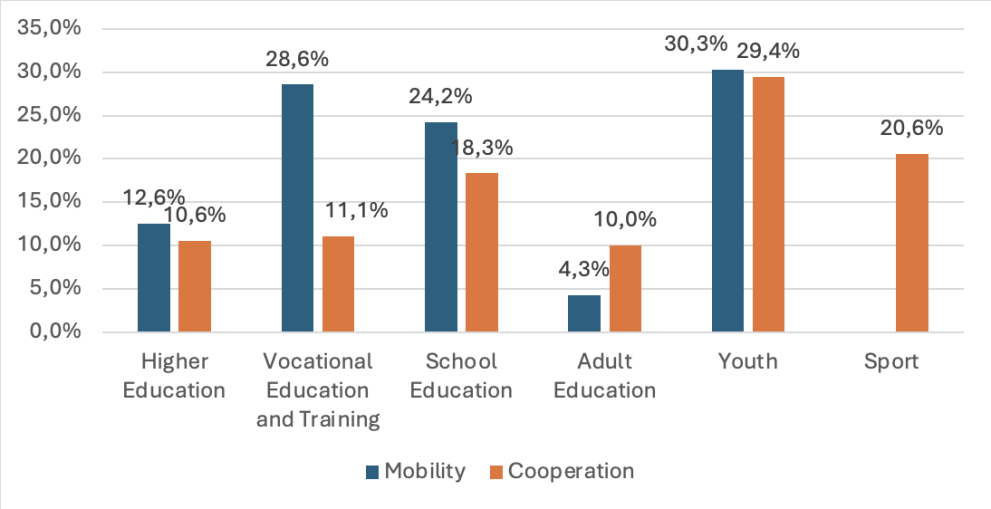
Source: Erasmus+ in Serbia in 2021. Statistics on mobility, cooperation and other data.
Figure 3: Number of organisations participated under Mobility and Cooperation projects in 2021 per sectors
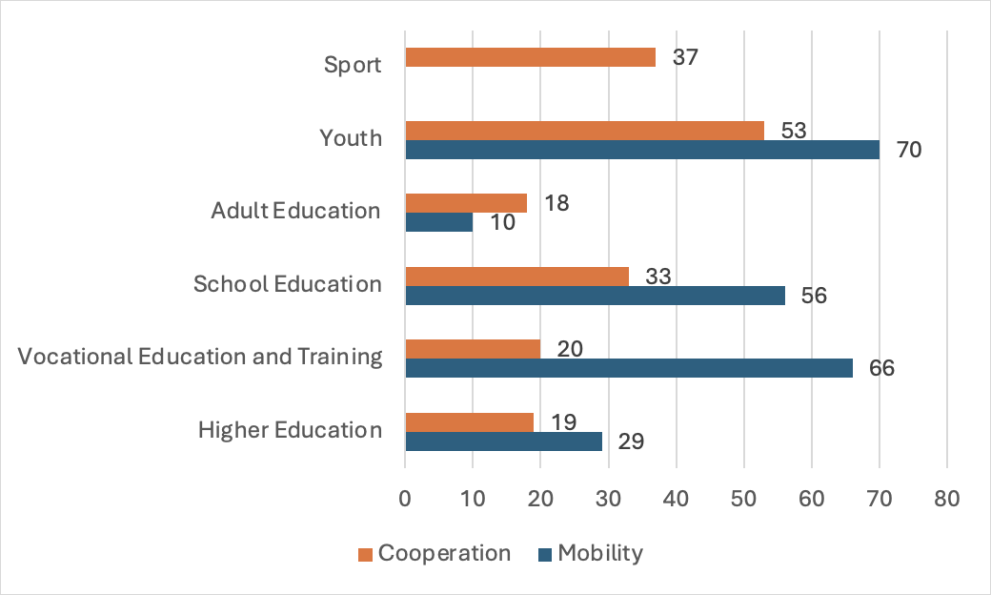
Source: Erasmus+ in Serbia in 2021. Statistics on mobility, cooperation and other data.
Breakdown of Erasmus+ Programme Support in 2022
Figure 4: Total grants approved under Mobility and Cooperation in 2022 (in EUR)
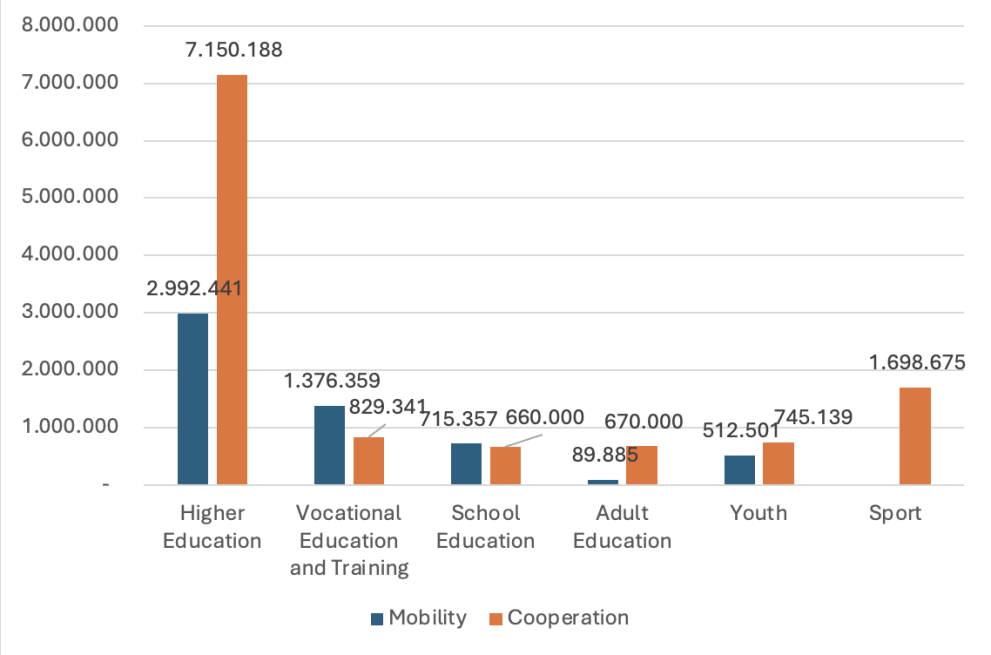
Source: Erasmus+ in Serbia in 2022. Statistics on mobility, cooperation and other data.
Figure 5: Number of projects under Mobility and Cooperation in 2022 per sectors
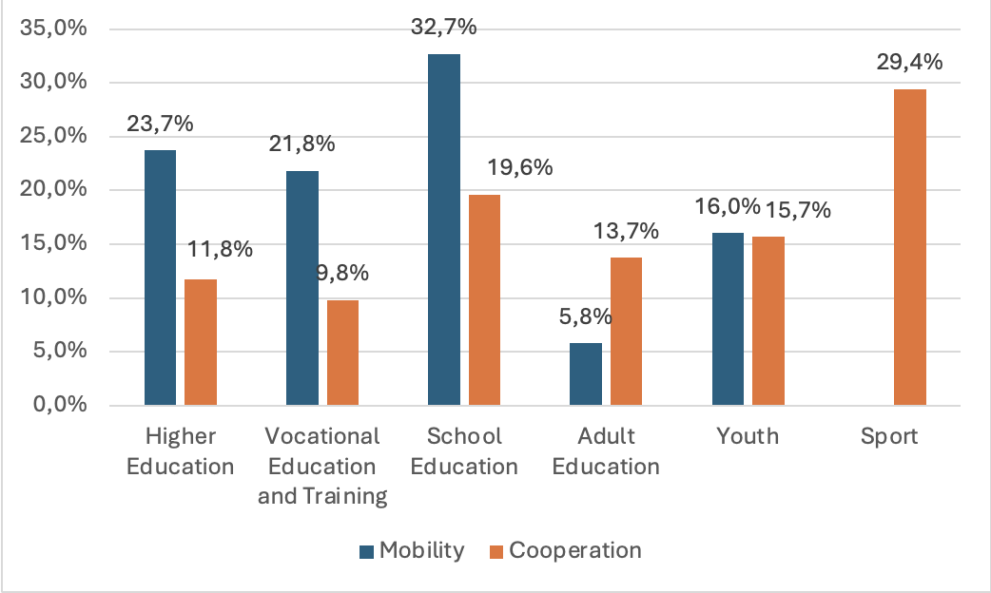
Source: Erasmus+ in Serbia in 2022. Statistics on mobility, cooperation and other data.
Figure 6: Number of organisations participated under Mobility and Cooperation projects in 2021 per sectors
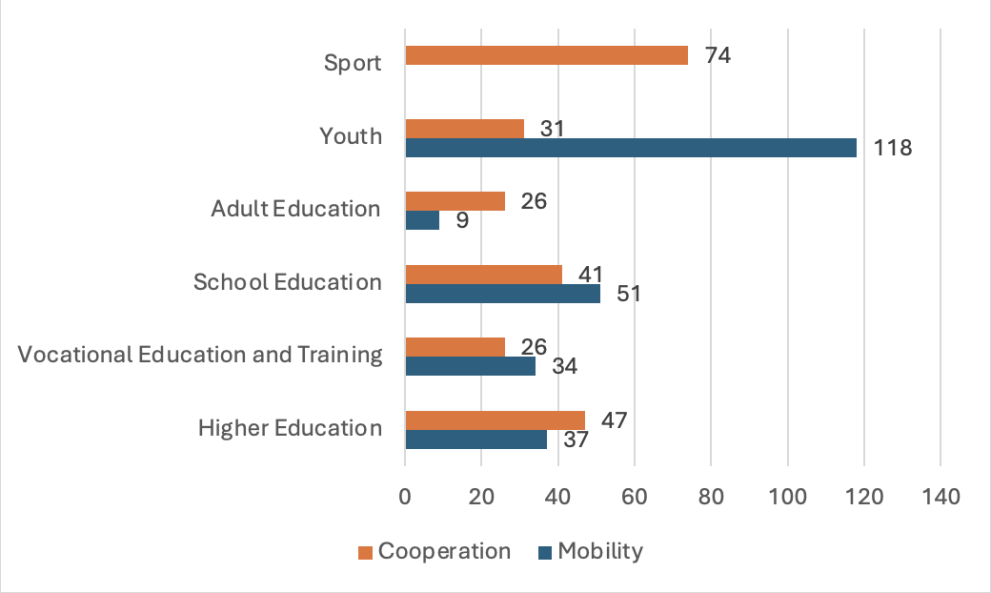
Source: Erasmus+ in Serbia in 2022. Statistics on mobility, cooperation and other data.
Breakdown of Erasmus+ Programme Support in 2023
As per the latest data for 2023, a total of 22 projects within KA1 component and 6 projects under KA2 component have been approved for funding. Breakdown of the approved grants in the field of youth is as follows:
-
KA151 - 1
-
KA152 - 11
-
KA153 - 5
-
KA154 - 3
-
KA155 - 2
-
KA210 - 3
-
KA220 - 3
With regards to centralised action - capacity building projects in the youth sector, a total of 39 projects with participating institutions from Serbia have been selected, out of which 4 projects led by Serbian institutions.
In overall, analysing the youth sector over the period 2019-2023, organisations from Serbia were partners in more than 1600 KA1 projects, compared to 98 where they were coordinators, reflecting strong sectoral engagement within the limited budgets. Serbian institutions frequently participate as partners in KA2 projects, expanding the programme's reach and fostering international cooperation. Serbian Higher Education Institutions were coordinators in a total of 22 KA2 projects from 2019 to 2023, while their partnership role expanded to 129 projects, amplifying their contribution to the programme's objectives. In the youth sector, Serbian organisations were coordinating around 20 KA2 projects from 2019 to 2023, while their partnership role expanded to almost 200 projects.
The Law on Youth (2011) defines legal basis for cooperation of institutions engaged in different youth policy aspects.
Another important coordination mechanism represents a Working Group for monitoring and implementation of the Youth Strategy (2023-2030), whose tasks are to propose measures to harmonise activities on the implementation of the Strategy, monitor the implementation and participate in the evaluation and preparation of reports for the Government. . Activities directly implemented by other ministries, institutions, civil society, business sector, etc., are monitored indirectly by the MoTY, through their reports.
The Youth Council has been established in 2014 within the Ministry of Youth and Sports (since 2022 positioned under the Ministry of Tourism and Youth). The Youth Council was entrusted with the role to stimulate and harmonize activities related to the development and implementation of youth policy proposing measures for its improvement, as well as to harmonize and coordinate intersectoral activities at the national level. It ensures that the needs of young people are reflected in the policies and enables youth participation in the development, implementation and monitoring of public policies.
The Youth Council involves 44 members of different ministries, youth offices and national councils of national minorities, youth organizations, organizations for youth and their associations enabling cross-sectoral, horizontal, inter-ministerial and interdepartmental approach to youth policy-making across various policy-making fields, aiming at maximizing the potential of youth policy. More on cross-sectoral approach between the ministries can be read in Chapter 1.5 Cross-sectoral approach with other ministries.
The Provincial Youth Council stimulates and coordinates activities related to the development and implementation of youth policy and propose measures for their improvement at the level of Autonomous Province of Vojvodina (APV). Provincial Youth Council is established and coordinated by the Provincial Secretariat for Sports and Youth.
The Local Youth Council (see Glossary) is another governmental advisory body of the Municipal Assembly/City Assembly responsible for cross-sectoral collaborative work. There are 78 active Local Youth Councils in Serbia. Councils gather members of different ministries, youth offices and national councils of national minorities, youth organizations, organizations for youth and their associations enabling cross-sectoral, horizontal, inter-ministerial and interdepartmental approach to youth policy-making across various policy-making fields, aiming at maximizing the potential of youth policy. It encourages, coordinates and monitors activities related to the development and implementation of youth policy at the local level and proposes measures for its improvement.
The Local Youth Council has two important roles:
- It is a body that allows young people to participate actively in decision-making;
- It is a body for networking and cross-sectoral cooperation with various institutions involved in the field of youth (schools, Ministry of Interior, National Employment Service, Health Centres, etc.).
The National Association of Youth Workers (NAPOR) gathers 47 organisations and 36 individuals with the aim of encouraging networking and exchange of knowledge and practice between associations that conduct youth work. NAPOR has for the quality assurance purposes, established a pool of licensed organisation and trainers for delivery of multi-modular trainings for non-formal education vocational standards as well as a pool of mentors for validation of previously acquired competences.
The National Youth Council of Serbia - KOMS as the highest representative body of the young population serves as an advocacy platform for the improving the position of young people and acts as a link between young people, their member organizations and various decision-makers and providers of youth programmes and services.
KOMS has launched a Pool of Trainers with the aim of improving capacity building programs, standardization of work and better work on its own development, support to member organizations and other youth policy actors. The concept was developed through a broad consultative process so that its form would be better adapted to the needs of all stakeholders.

